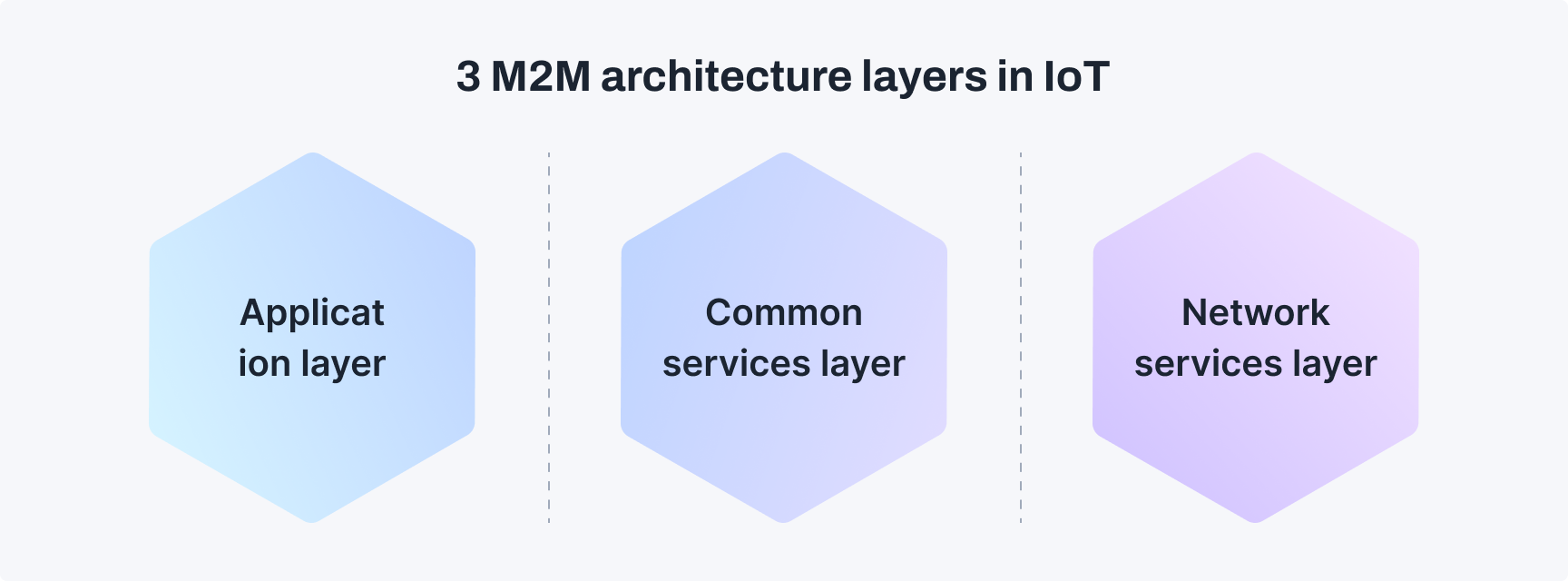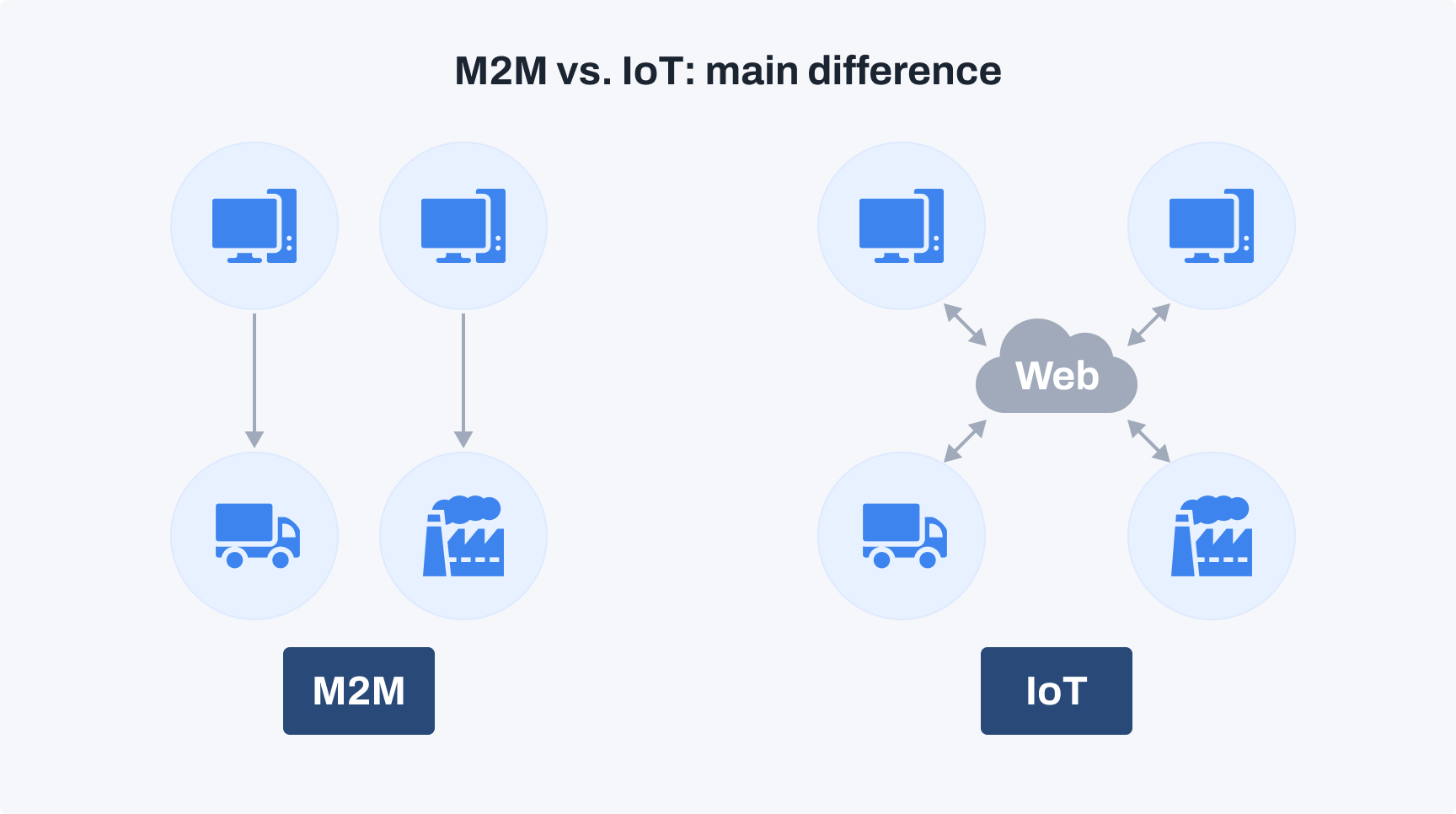M2M Architecture in IoT & Difference between IoT and M2M
March 28, 2024In the vast Internet of Things (IoT) ecosystem, Machine-to-Machine (M2M) communication forms the backbone, enabling devices to interact and share data autonomously without human intervention.
M2M architecture in IoT defines the structural framework that governs how these devices communicate, exchange information, and collaborate seamlessly. This architecture lays the groundwork for building robust, scalable, and efficient IoT systems, shaping the future of interconnected devices and smart technologies.
Let's take a look at the fundamentals of M2M IoT architecture, examining its three key layers and highlighting the primary distinctions between M2M and IoT.
What is M2M architecture in IoT?

M2M refers to the communication between devices without human intervention. M2M (Machine-to-Machine) architecture facilitates the transfer of information between components and allows for the operation of different devices without any difficulty. That's the essence of it, delivering such devices the ability to communicate with each other, whether it's through wires or wireless transmissions, to be able to share and take action without having many human interventions. It has established a protocol of using a specific language so various devices, ranging from a robot to a printer, to an HVAC system, can exchange data safely and quickly.
The role of gateways is that they are the entry points that gather data from various devices, and cloud platforms or central portals are the sites where the data is stored and processed. The modern procedure of using data analytics tools helps explain all the collected data and turn it into usable information. Safety is taken into account by all this communication so that it remains unharmed, while user interfaces provide a rather simple way for people to interact with the IoT system. There are three layers in M2M architecture:
Application layer
This layer focuses on connectivity between IoT devices and their applications, including protocols and standardized API definitions for business intelligence systems.
Common services layer
It provides a horizontal framework across vertical industry applications, encompassing the physical network, management protocols, and hardware necessary for IoT applications.
Network services layer
This layer is the communication domain for IoT devices and endpoints, incorporating different networking standards like IEEE for efficient communication.
The functional M2M IoT architecture includes components that communicate with each other through reference points, ensuring seamless connectivity within the infrastructure domain. Overall, M2M IoT architecture provides a structured approach to enable machine-to-machine communication, offering a standardized framework for connectivity, data exchange, and interoperability across diverse IoT applications and industries.
Also, look at Message Queuing Telemetry Transport (MQTT), a lightweight messaging protocol ideal for M2M communication within IoT networks. It enables efficient, reliable, and real-time data exchange between devices, even in low-bandwidth and unreliable network environments. MQTT's publish-subscribe architecture allows devices to communicate asynchronously, minimizing network overhead and facilitating scalable IoT deployments.
With its widespread adoption and support across various platforms and devices, MQTT serves as a foundational protocol for building interoperable and resilient M2M communication systems, aligning with the goals of the oneM2M initiative for standardized IoT connectivity.
Top 6 main differences between M2M and IoT

The main differences between M2M and IoT lie in their connectivity, scalability, and scope. Here are the key distinctions based on the provided search results:
1. Connection type
M2M involves point-to-point communication between two or more devices without human interaction, often wired or wireless. IoT extends the internet into machines, allowing them to connect and communicate with each other via various communication types over networks.
2. Data sharing
In IoT, data is shared between multiple applications to enhance the end-user experience. M2M shares data only between the communicating parties involved in direct communication.
3. Internet dependency
IoT devices require an internet connection for communication and operation. M2M systems can function without internet connectivity, relying on direct point-to-point communication.
4. Communication protocol
IoT typically uses internet protocols like HTTP, FTP, and Telnet for communication. Instead, M2M relies on traditional protocols and communication technologies for data exchange.
5. Scope
IoT has a broader scope, supporting many devices and users within a connected ecosystem. M2M has a more limited scope, often focusing on specific applications or industries with point-to-point communication.
6. Business applications
IoT caters to Business-to-Business (B2B) and Business-to-Consumer (B2C) scenarios, offering open API support for integrations. M2M is more specialized, providing solutions tailored to specific device requirements without open API support.
While M2M and IoT facilitate machine-to-machine communication without human intervention, IoT expands on M2M by leveraging internet connectivity, supporting a broader range of applications, and offering scalability for large networks of interconnected devices.
M2M vs. IoT comparison table
| IoT | M2M | |
|---|---|---|
| Intelligence | Devices have objects for decision-making | Some degree of intelligence is observed in this |
| Communication protocol | HTTP, FTP, and Telnet | Traditional protocol |
| Internet | An internet connection is required | Devices aren’t dependent on the internet |
| Requirements | Generic commodity devices | Specialized device solution |
| Business type | B2B, B2C | B2B |
| Communication type | Cloud communication | Point-to-point |
| Examples | Smart cities, Big data, etc. | Sensors, data, information, etc. |
Conclusion
M2M architecture in IoT systems enables seamless communication and data exchange between devices. Adopting standardized protocols like oneM2M promotes interoperability and scalability, fostering innovation across various industries.
Understanding the differences between M2M and IoT is essential for building robust and efficient IoT ecosystems and driving the next wave of technological advancements and digital transformation.
Do you have difficulties configuring communication between your IoT devices? Contact us, and our experts will reach out to provide assistance.




